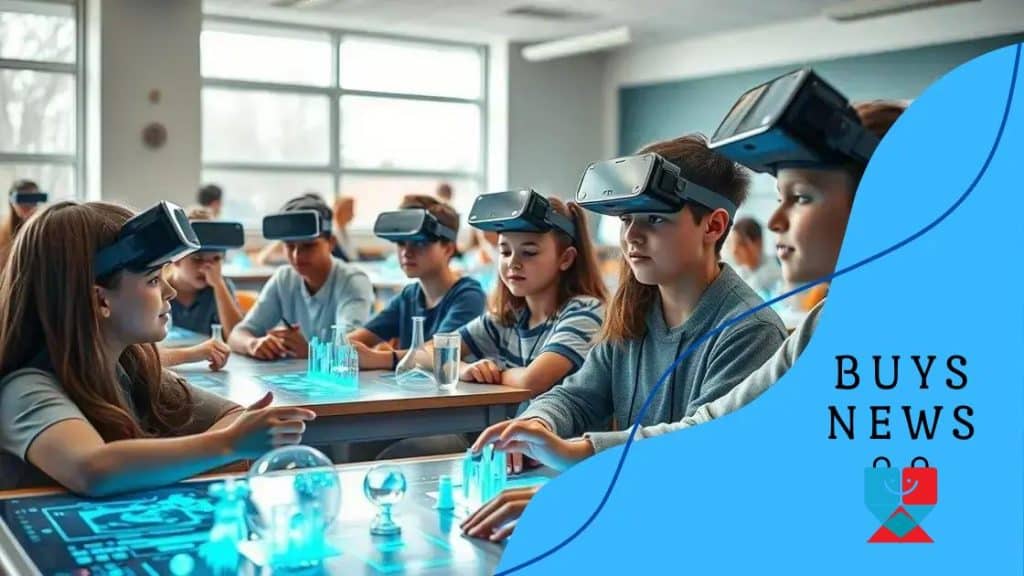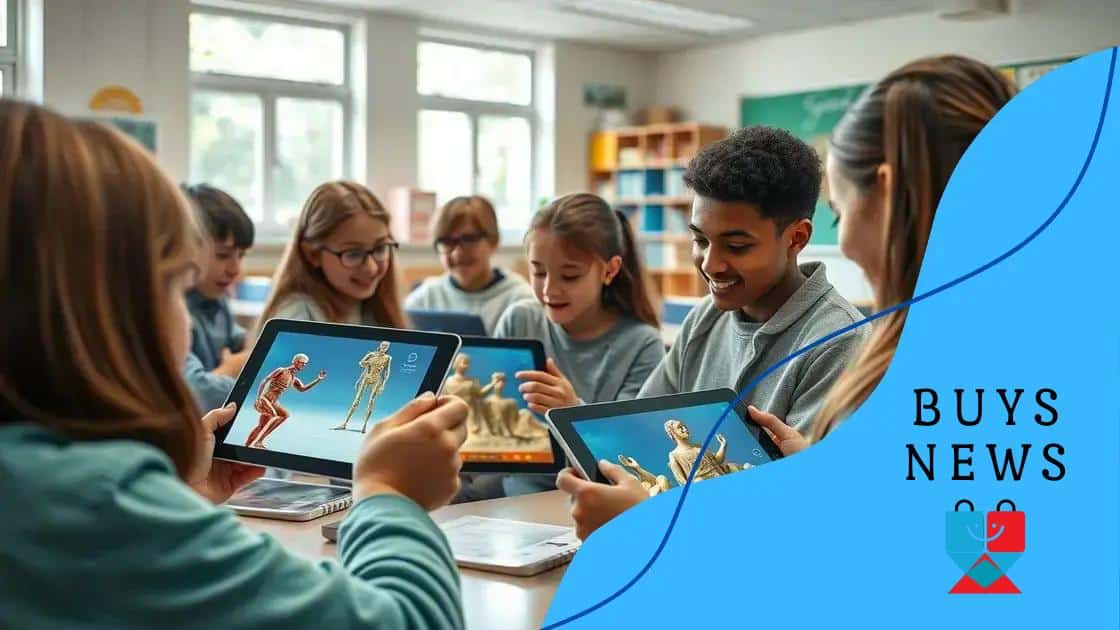How AR is being used for hands-on learning experiences

Augmented reality (AR) is transforming education by enhancing student engagement, providing personalized learning experiences, and fostering collaboration while facing challenges like costs and technology integration.
How AR is being used for hands-on learning experiences is a game-changer in education, sparking curiosity among students. Have you ever wondered how lifelike simulations can enhance understanding? This article invites you to explore how AR brings learning to life.
Understanding augmented reality in education
Understanding augmented reality in education is essential for enhancing how students learn. It creates a unique bridge between the digital and physical worlds, enabling students to engage with content in innovative ways. Imagine learning about the solar system while seeing planets in 3D right in your classroom!
What is Augmented Reality?
Augmented reality (AR) adds digital elements to a live view, often using a camera or smartphone. This technology allows students to interact with digital information superimposed on their real-world environment. For instance, students can explore how anatomical structures function through interactive models.
Benefits of AR in Education
- Enhanced Engagement: AR captures students’ attention, making learning more exciting.
- Interactive Learning: Students can learn by doing, which improves retention.
- Real-World Applications: Concepts taught in classes can be applied in real-time scenarios.
Moreover, AR supports diverse learning styles. Visual learners benefit from seeing information interactively, while kinesthetic learners can manipulate digital objects to understand concepts better. This adaptability makes AR a powerful educational tool.
As educators incorporate AR into their lessons, they can provide students with a richer understanding of complex topics. The ability to visualize chemical reactions or historical events helps solidify knowledge in a way that traditional methods may not achieve.
Additionally, AR can facilitate collaboration among students. Working together to solve problems or create projects using AR tools enhances teamwork and communication skills. Learning in a collaborative environment prepares students for future workplace challenges.
Challenges of Implementing AR
Despite its advantages, there are challenges to implementing AR in education. Schools must consider the cost of technology and training for teachers. Additionally, ensuring that AR content aligns with educational standards is crucial.
Benefits of AR for hands-on learning
The benefits of AR for hands-on learning are numerous. This technology enhances the educational experience by making lessons interactive and engaging. Students can grasp complex concepts more easily when they can visualize and interact with them.
Increased Engagement
One of the primary advantages of AR is its ability to capture students’ attention. Traditional methods can sometimes fail to engage learners, but AR brings subjects to life. For example, rather than reading about the human body, students can view a 3D model and explore its functions.
Improved Retention of Information
Experiential learning helps students retain information better. With AR, they actively participate in their education. This hands-on approach leads to greater understanding and memory recall.
- Visual Learning: Students see concepts in action.
- Active Participation: Hands-on activities keep learners engaged.
- Real-World Applications: Lessons become relevant to daily life.
Moreover, AR accommodates various learning styles. Visual learners benefit from seeing information, while kinesthetic learners appreciate the physical interaction. This adaptability allows teachers to reach a wider range of students.
AR also fosters collaboration among peers. Students can work together on projects that require using AR tools, promoting teamwork and communication. Such collaboration mirrors real-world scenarios, preparing students for future endeavors.
Examples of AR applications in classrooms

There are many examples of AR applications in classrooms that demonstrate how this technology is changing education. Teachers are increasingly using AR to create interactive learning experiences for students.
Interactive Learning Environments
One popular application is using AR to create interactive maps. For example, students can explore historical sites or geographical features by pointing their devices at physical maps. This makes learning about the world more engaging and memorable.
Science Lessons with 3D Models
Another exciting use of AR is in science classes. Students can examine 3D models of molecules or organs, giving them a deeper understanding of complex concepts. By visualizing these structures, they can see how they function and interact.
- Biology: Explore the human anatomy in detail.
- Chemistry: Visualize molecular structures and reactions.
- Physics: Simulate experiments and observe outcomes in real-time.
These AR tools allow students to learn through exploration and experimentation, deepening their knowledge. They provide hands-on opportunities that traditional methods cannot match.
In language classes, AR can also enhance learning. Students can scan images that trigger interactive narratives or translations, making the process of learning new languages more fun and engaging. Each interaction helps reinforce vocabulary and grammar.
AR Field Trips
Additionally, AR holds the potential for virtual field trips. Students can visit museums or historical landmarks without leaving the classroom. For instance, using AR apps, they can see artifacts up close and learn about them in an immersive way.
This technology not only makes learning accessible but also inspires curiosity and excitement about different subjects. By integrating AR into lessons, educators can create a dynamic learning environment.
Challenges in integrating AR technology
Integrating AR technology in education presents several challenges. It is essential to understand these obstacles to implement AR effectively in classrooms. One major concern is the cost associated with acquiring AR tools and software.
Financial Constraints
Many schools face budget limitations that can hinder the purchase of AR devices and software licenses. This can restrict the use of AR in classrooms, especially in underfunded districts. Despite the benefits, schools must prioritize their spending on essential resources.
Technical Issues
Another challenge involves the technical aspects of AR. Not all educators are familiar with AR tools and how to use them. Training staff to effectively integrate AR into their teaching is crucial. Schools may need to invest time and resources in professional development.
- Device Compatibility: Not all devices can run AR applications smoothly.
- Software Updates: Keeping software current can be time-consuming and costly.
- Internet Connectivity: A stable internet connection is essential for AR functionality.
Additionally, there are concerns about content quality. Some AR applications may not align with educational standards or curricular goals. Teachers must evaluate the effectiveness of the tools they select to ensure they enhance learning.
Furthermore, student accessibility to AR technology can pose problems. If only some students have access to devices, it creates inequality in the learning process. Schools need to find solutions to equip all students with the necessary tools for a balanced learning environment.
Classroom Management
Using AR can change classroom dynamics. Teachers may struggle to manage increased student engagement and excitement, which can lead to distractions. Finding a balance between interaction and focused learning can be challenging.
Future trends in AR for education
As we look at the future trends in AR for education, it’s clear that this technology will continue to evolve and reshape the learning experience. With advancements in AR tools and software, the possibilities for educational applications are growing rapidly.
Personalized Learning Experiences
One significant trend is the move towards personalized learning. AR allows educators to tailor experiences to meet the unique needs of each student. For instance, students can interact with content that aligns with their interests and skill levels, making learning more relevant and engaging.
Integration with AI
Additionally, the integration of AR with artificial intelligence (AI) is set to enhance educational outcomes. AI can analyze student performance and adapt AR content accordingly. This means that lessons can become more dynamic and responsive to student needs.
- Adaptive Learning Tools: Programs that change based on student progress.
- Intelligent Tutoring Systems: Personalized assistance through AR.
- Enhanced Engagement: Interactive elements that keep students interested.
Moreover, makerspaces and STEAM programs will likely incorporate more AR applications. This combination will encourage exploration and creativity, allowing students to engage in hands-on learning while using AR to visualize their projects.
Another trend is the increased accessibility of AR technology. As devices become more affordable and widespread, even underfunded schools can gain access to AR tools. This democratization of technology can provide more students with enriching learning experiences.
Collaboration with AR
Collaborative learning experiences will also be a key focus. AR enables students to work together on projects regardless of their physical location. Virtual classrooms will allow students to collaborate on tasks in real-time, fostering teamwork and communication skills.
Lastly, we can expect to see significant growth in AR content development. As more educators recognize the potential of AR, the demand for quality educational content will increase. This will lead to a wider array of AR resources available for various subjects and grade levels.
FAQ – Frequently Asked Questions about AR in Education
What are the main benefits of using AR in classrooms?
AR enhances student engagement, provides personalized learning experiences, and encourages collaboration among peers.
How can teachers effectively integrate AR technology?
Teachers can start by participating in professional development, using AR applications that align with their curriculum, and gradually incorporating AR tools in their lessons.
What are some challenges faced when implementing AR in schools?
Challenges include financial constraints, technical issues, and ensuring equitable access to technology for all students.
What future trends can we expect for AR in education?
Future trends include personalized learning experiences, integration with AI, and increased accessibility of AR tools for all schools.





